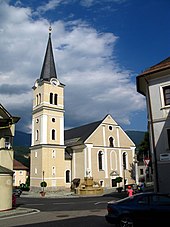Parish Church of Paternion
The parish church of Paternion is on Anna-Plazotta-Platz below the Paternion Castle in the village of the same name . The patronage of Paternianus indicates that the parish belonged to the Patriarchate of Aquileja from 811 to 1786. The church was first mentioned in a document in 1296. Between 1330 and 1341 there was a collegiate monastery in Paternion . During the Reformation the parish was united with Nikelsdorf and Feistritz under an evangelical preacher. In 1765 the gothic nave of the church was removed and a north-facing church was built with the old choir as a side chapel.
Building description
The nave has a wide gable roof. The south façade, which is also the main façade, is structured by pilasters and curved window shapes, the straight lintel portal is crowned by a blown gable. The retracted choir ends in a semicircular apse. The three-storey tower with two-part acoustic windows, located to the west of the nave, is crowned by a pointed helmet with segmented gables. Between the tower and the choir there is a baroque chapel extension with rounded corners and a detached roof. In the east of the nave, the two-storey, baroque sacristy is attached. To the south of this is the choir of the old church, today a chapel, with three pointed arched windows and two-tiered buttresses , which have been renewed in the upper part. A late baroque crucifix hangs in the niche between the sacristy and the Gothic choir . On the back wall in 1842 Christoph Brandstätter painted Maria , Johannes and Maria Magdalena and Jerusalem as a background. To the left of it he depicts the baptism of Jesus and above it the resurrection , to the right the transfiguration of the Lord on Mount Tabor and above it the ascension of Christ . On the southern outer wall there is a Roman epitaph for the natives Tinco, Banana and Ambidrabus, above the southern portal an altar of consecration for Mithras .
In the three-bay hall hall, a square vault rests on pilasters. The yokes are separated by belt arches . In the wider central yoke, two side chapels are built on like a transept. The Gothic choir of the old church with a five-eighth closure has a ribbed star vault with a round keystone with a painted Madonna and Child. The windows with the representations of Saints Joseph, Johannes Ev. and Paternianus were made by Strobl and Jäger from Brixen at the end of the 19th century. The two figural glass paintings in the chapel opposite were created by Karl Weiser in 1953 in memory of Countess Elisabeth Foscari-Widmann-Rezzonico. The brick gallery on four delicate wooden columns protrudes in the middle. On the gallery there is a wooden singing street with an organ made by Jakob Ladstätter around 1860. A round arched triumphal arch with pilasters connects the nave with the single-bay choir.
Murals
The wall paintings from the second half of the 18th century were partially painted over in the 19th century. The Last Supper in the choir vault is surrounded by four Old Testament scenes. The painting in the northern yoke shows the descent of the Holy Spirit . The glorification of St. Paternianus in the Mitteljoch is probably the work of the Swabian painter Eustachius Gabriel . In the southern yoke a Madonna is depicted enthroned with St. Joseph .
Facility
The altar, marked 1776 in a chronogram , shows the glorification of St. Paternian on the middle picture and the coronation of Mary on the upper picture . Both of these pictures are from Anton Leberberger. Next to the central picture are the carved figures of the princes of the apostles Peter and Paul .
The rosary altar from 1715 in the former choir hides in the central niche an enthroned Mother of God who is adored by Saints Dominic and Catherine of Siena . To the side are the statues of Saints Benedict and Francis of Assisi . God the Father forms the essay with angels.
The altar in the chapel opposite is made of marble with stone inlays and was probably made in a Ljubljana workshop in the third quarter of the 18th century. The central image by Antonörenberger depicting St. Florian is flanked by the stone figures Peter and Paul.
In the chapel to the left and right of the high altar there are neo-baroque altars. On the left altar there is a plastic crucifixion group by Joseph Mayer, on the right the figures of Saints Joseph and Norbert and the church saint Paternianus.
The pulpit , made around 1720, is painted with the evangelists .
The church also has a baptismal font from 1652, console figures of Saints Joseph and Joachim from the 18th century, neo-baroque console figures of Johannes Nepomuk and a Man of Sorrows from the second half of the 19th century and a console figure of Saint Paternianus from the end of the 15th century baroque version .
literature
- Dehio manual. The art monuments of Austria. Carinthia . Anton Schroll, Vienna 2001, ISBN 3-7031-0712-X , p. 614 f.
- Barbara Neubauer -Kienzl, Wilhelm Deuter and Eduard Mahlknecht: "Baroque in Carinthia - With a contribution by Eva Berger". Carinthia University Press, Klagenfurt 2000, ISBN 3-85378-489-5 , pp. 83 and 187.
Web links
Coordinates: 46 ° 42 ′ 44.9 ″ N , 13 ° 38 ′ 14.9 ″ E



